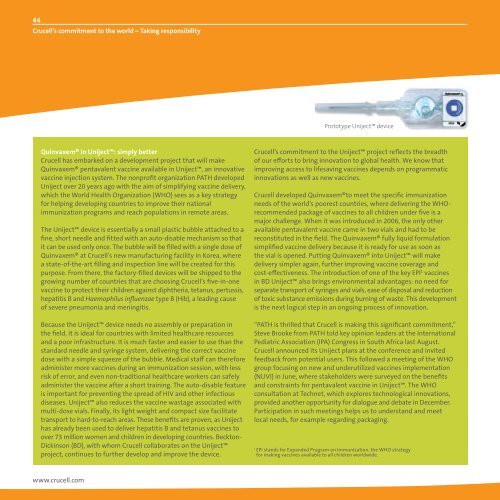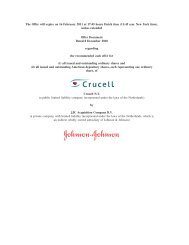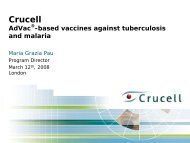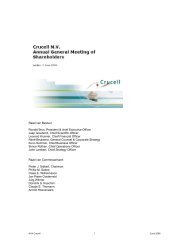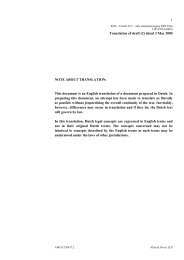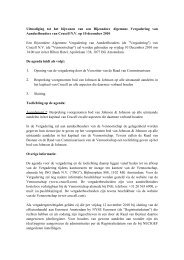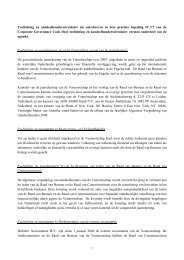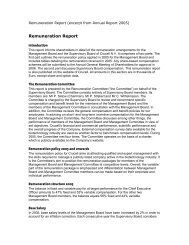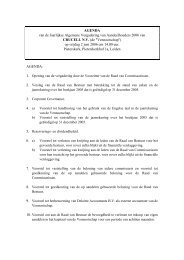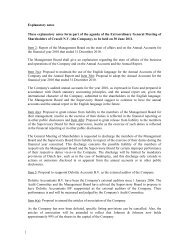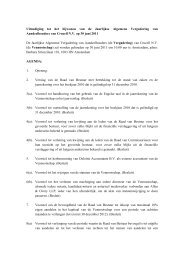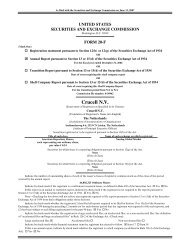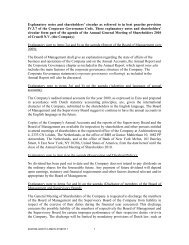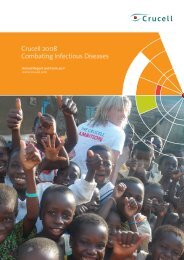Crucell corporate brochure (PDF)
Crucell corporate brochure (PDF)
Crucell corporate brochure (PDF)
Create successful ePaper yourself
Turn your PDF publications into a flip-book with our unique Google optimized e-Paper software.
44<br />
<strong>Crucell</strong>’s commitment to the world – Taking responsibility<br />
Quinvaxem® in Uniject: simply better<br />
<strong>Crucell</strong> has embarked on a development project that will make<br />
Quinvaxem® pentavalent vaccine available in Uniject, an innovative<br />
vaccine injection system. The nonprofit organization PATH developed<br />
Uniject over 20 years ago with the aim of simplifying vaccine delivery,<br />
which the World Health Organization (WHO) sees as a key strategy<br />
for helping developing countries to improve their national<br />
immunization programs and reach populations in remote areas.<br />
The Uniject device is essentially a small plastic bubble attached to a<br />
fine, short needle and fitted with an auto-disable mechanism so that<br />
it can be used only once. The bubble will be filled with a single dose of<br />
Quinvaxem® at <strong>Crucell</strong>’s new manufacturing facility in Korea, where<br />
a state-of-the-art filling and inspection line will be created for this<br />
purpose. From there, the factory-filled devices will be shipped to the<br />
growing number of countries that are choosing <strong>Crucell</strong>’s five-in-one<br />
vaccine to protect their children against diphtheria, tetanus, pertussis,<br />
hepatitis B and Haemophilus influenzae type B (Hib), a leading cause<br />
of severe pneumonia and meningitis.<br />
Because the Uniject device needs no assembly or preparation in<br />
the field, it is ideal for countries with limited healthcare resources<br />
and a poor infrastructure. It is much faster and easier to use than the<br />
standard needle and syringe system, delivering the correct vaccine<br />
dose with a simple squeeze of the bubble. Medical staff can therefore<br />
administer more vaccines during an immunization session, with less<br />
risk of error, and even non-traditional healthcare workers can safely<br />
administer the vaccine after a short training. The auto-disable feature<br />
is important for preventing the spread of HIV and other infectious<br />
diseases. Uniject also reduces the vaccine wastage associated with<br />
multi-dose vials. Finally, its light weight and compact size facilitate<br />
transport to hard-to-reach areas. These benefits are proven, as Uniject<br />
has already been used to deliver hepatitis B and tetanus vaccines to<br />
over 73 million women and children in developing countries. Beckton-<br />
Dickinson (BD), with whom <strong>Crucell</strong> collaborates on the Uniject<br />
project, continues to further develop and improve the device.<br />
www.crucell.com<br />
Prototype Uniject device<br />
<strong>Crucell</strong>’s commitment to the Uniject project reflects the breadth<br />
of our efforts to bring innovation to global health. We know that<br />
improving access to lifesaving vaccines depends on programmatic<br />
innovations as well as new vaccines.<br />
<strong>Crucell</strong> developed Quinvaxem®to meet the specific immunization<br />
needs of the world’s poorest countries, where delivering the WHOrecommended<br />
package of vaccines to all children under five is a<br />
major challenge. When it was introduced in 2006, the only other<br />
available pentavalent vaccine came in two vials and had to be<br />
reconstituted in the field. The Quinvaxem® fully liquid formulation<br />
simplified vaccine delivery because it is ready for use as soon as<br />
the vial is opened. Putting Quinvaxem® into Uniject will make<br />
delivery simpler again, further improving vaccine coverage and<br />
cost-effectiveness. The introduction of one of the key EPI 1 vaccines<br />
in BD Uniject also brings environmental advantages: no need for<br />
separate transport of syringes and vials, ease of disposal and reduction<br />
of toxic substance emissions during burning of waste. This development<br />
is the next logical step in an ongoing process of innovation.<br />
“PATH is thrilled that <strong>Crucell</strong> is making this significant commitment,”<br />
Steve Brooke from PATH told key opinion leaders at the International<br />
Pediatric Association (IPA) Congress in South Africa last August.<br />
<strong>Crucell</strong> announced its Uniject plans at the conference and invited<br />
feedback from potential users. This followed a meeting of the WHO<br />
group focusing on new and underutilized vaccines implementation<br />
(NUVI) in June, where stakeholders were surveyed on the benefits<br />
and constraints for pentavalent vaccine in Uniject. The WHO<br />
consultation at Technet, which explores technological innovations,<br />
provided another opportunity for dialogue and debate in December.<br />
Participation in such meetings helps us to understand and meet<br />
local needs, for example regarding packaging.<br />
1 EPI stands for Expanded Program on Immunization, the WHO strategy<br />
for making vaccines available to all children worldwide.


